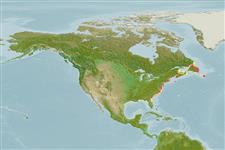Common names from other countries
Environment: milieu / climate zone / depth range / distribution range
Ecología
; rango de profundidad 11 - 16 m (Ref. 1239). Subtropical
Distribución
Países | Áreas FAO | Ecosistemas | Ocurrencias, apariciones | Introducciones
Western Atlantic: USA and Canada. Tropical to polar climates of northern hemisphere.
Length at first maturity / Tamaño / Peso / Age
Maturity: Lm ? range ? - ? cm Max length : 0.2 cm TL macho / no sexado; (Ref. 1239); common length : 0.1 cm TL macho / no sexado; (Ref. 1239)
Found in the littoral zone. Active hunter (Ref. 111265).
Life cycle and mating behavior
Madurez | Reproducción | Puesta | Huevos | Fecundidad | Larva
Members of the class Aplacophora are mostly hermaphroditic. Life cycle: Eggs hatch into lecitotrophic larvae which later develop into adults.
Morse, M.P. and J.L. Norenburg. 1992. (Ref. 1239)
IUCN Red List Status (Ref. 130435)
CITES status (Ref. 108899)
Not Evaluated
Not Evaluated
Threat to humans
Harmless
Human uses
| FishSource |
Herramientas
Más información
Age/Size
Crecimiento
Length-weight
Length-length
Morfología
Larva
Abundancia
Fuentes de Internet
Estimates based on models
Preferred temperature
(Ref.
115969): 3.1 - 23.7, mean 7.2 (based on 168 cells).
Vulnerability
Low vulnerability (10 of 100).
Price category
Unknown.
